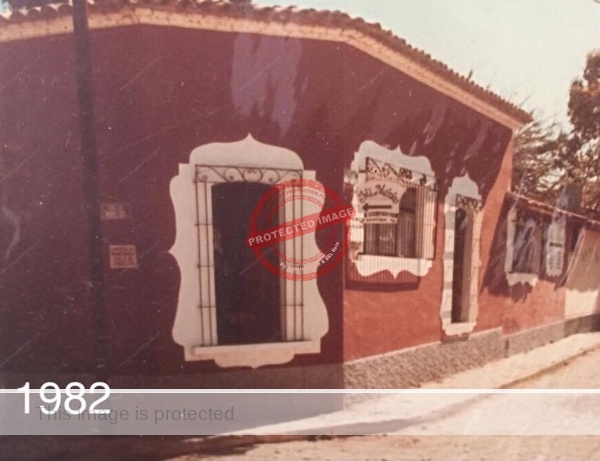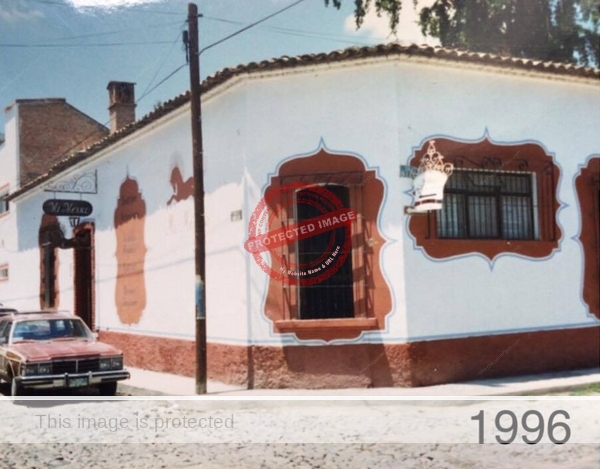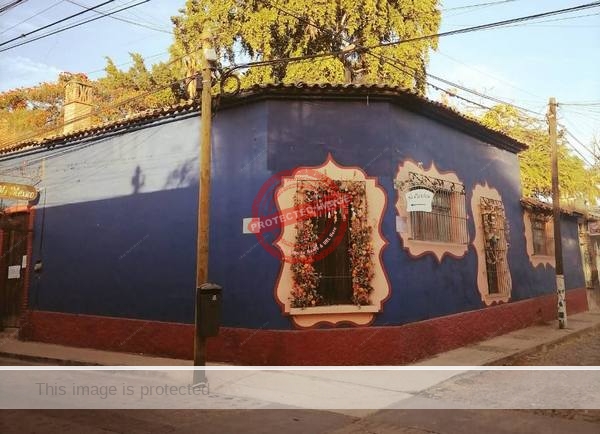There are not many genuinely old buildings left in Ajijic. Most of those that survived into the 1970s have since been modified or remodeled beyond recognition. One exception is the building at Morelos #8, one block back from the pier, which housed (until mid-February 2025) the store Mi México. It is a rare survivor, largely unchanged for the past 80 years or more.

Mi Mexico, 1982. Photo courtesy of Alejandro Wagner
I don’t know for sure who built it or precisely how old the building actually is. But I do know—based on my research into the influence of foreigners at Lake Chapala—that this building was acquired in 1937 as a vacation home by U.S. entrepreneur Louis E. Stephens, then living in Mexico City. Stephens had first learned about the delights of living in Mexico—and of Ajijic in particular—from screenplay writer Charles Kaufman, who had lived in the village in 1929. Kaufman’s novel Fiesta in Manhattan (1939), which tells the story of a young village musician and his wife who are encouraged to leave their lives at Lake Chapala for the bright lights of Manhattan, is actually dedicated by its author to the people of Ajijic.
Stephens and his then-wife Annette Margolis (later known as Annette Nancarrow, artist and assistant to José Clemente Orozco) were exceptionally well-connected. They were members of the literary, artistic and cultural elite of Mexico City, and often offered the use of their Ajijic property to friends.
The most significant of these friends (from our narrow perspective) was U.S. fashion designer Helen Beth Kirtland, whose husband was a noted Mexico City rare books dealer. When Kirtland decided to separate from her husband, Stephens offered her and her three young children the use of his Ajijic home.

Mi Mexico, 1996. Photo courtesy of Alejandro Wagner
Their first visit in 1946 was for only a short time, but a year later Kirtland moved to Ajijic permanently with her children and never looked back. She founded Telares Ajijic (Ajijic Hand Looms), employed weavers and, through enterprise, good fortune and hard work, built up a highly successful business. She also opened her own store, Mi México. Her children all grew up in the village.
After completing college in California, her daughter, Katie Goodridge Ingram, born in Mexico City in 1938, returned to Ajijic and ran the Galería del Lago from 1975 until it closed in 1977. Ingram then opened her own gallery as part of Mi México, which she ran from 1978 to 1983. Ingram, an award-winning poet, later wrote an absorbing and beautifully written memoir of her childhood in Mexico City and Ajijic—According to Soledad, memories of a Mexican childhood—which garnered rave reviews following its publication in 2020.
Many other famous artists and authors have vacationed in or visited the Mi México building over the years. They include Algerian-born painter Violette Mège and her award-winning artist husband, Michael Baxte, in the 1940s. And, because of Kirtland, German poet Gustav Regler lived and wrote here in the late 1940s, and Erik Erikson (Young Man Luther) did so in the 1950s. Helen Kirtland’s tocaya and good friend Helen O’Gorman (wife of architect-artist Juan O’Gorman) visited more than once.

Mi Mexico, 2024. Photo courtesy of Alejandro Wagner
Kirtland later married American sculptor Mort Carl, who deserves the credit for building Ajijic’s first tennis court in an empty lot immediately behind the Mi México building. Carl’s work became better known after he abandoned Kirtland and Ajijic to return to the U.S. And, much more recently, I’m reliably informed that novelist Edgar Taylor Morris lived at Mi México while writing All the Clouds’ll roll away.
Mi México has now relocated to Riberas del Pilar, but this Ajijic landmark’s historical, literary and artistic heritage deserve to be recognized for many years to come. The building’s owners want to sell. Any ‘renovation’ would need prior approval from the Chapala municipality, which has apparently promised to preserve the facade. Will local authorities step up when needed to ensure its future? Only time will tell.
- Foreign Footprints in Ajijic: Decades of Change in a Mexican Village has more history of the artistic community in Ajijic.
Comments, corrections and additional material are welcome, whether via comments or email.
Tony Burton’s books include “Lake Chapala: A Postcard History” (2022), “Foreign Footprints in Ajijic” (2022), “If Walls Could Talk: Chapala’s historic buildings and their former occupants” (2020), (available in translation as “Si Las Paredes Hablaran”), “Mexican Kaleidoscope” (2016), and “Lake Chapala Through the Ages” (2008).
always captivating work.-This brought to mind probably my first or second visit to Ajijic about 1978. A friend from gdl took me and there. A horrible broken rock ran lane up a hillside.He always bought bread from a woman of great age in an, I guess, adobe house. It was not a bakery. She made the bread and I laugh as by today’s standards many would find it too unsanitary to eat. However, my friend was correct and it was delicious bread. .
Those were the days!